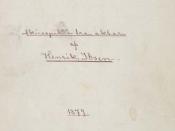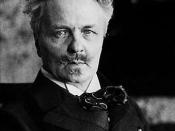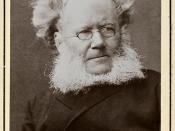Ibsen and Strindberg are two playwrights of the same period, the Industrial Revolution. This is a time when the world is making a great change in how it runs. Not only is business changing, the way people think is changing too. People are beginning to question the ways of society. For an example, questions are arising on how women should really be treated. Such notions give way to very controversial theatre. Ibsen and Strindberg strongly demonstrate how these issues were reasoned.
It generally seems as though Ibsen and Strindberg had a very different view on women and their roles in society. However, in a closer view you tend to see that their views on women are not that different. In Ibsen's A Doll's House and in Strindberg's Miss Julie it looks as if the women are mere objects. The women appear more like puppets or toys to the men.
The men use the women to satisfy their needs and not much else. There does not seem to be any respect at all from the men towards the women. Nevertheless, as far as the women go, they are expected to give full honor and respect to the men who treat them in such a manner. An example of this from Ibsen is Torvald having Nora dance the Tarantella in A Doll's House. The Tarantella is not a suitable dance for a married woman to be dancing but Torvald has her dance it anyway. This shows how Nora is simply a trophy that Torvold shows off to all of his friends. Her purpose to Torvald is to make him look good, without her doing that, she is almost pointless to him. With Strindberg, a perfect example is Jean showing no remorse for Julie after she must suffer the consequences...


